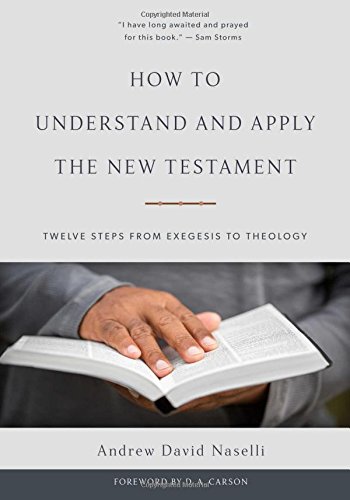Few responsibilities are more basic to Christian ministry than interpreting God’s Word rightly (2 Tim. 1:13; 2:15), and doing so responsibly requires much prayerful brain sweat – presuming to speak for God is serious business, after all. But what a joyful and rewarding endeavor it is.
A quick glance through the Table of Contents of Andy Naselli’s new book gives a quick sense of the complex breadth of study and depth of learning that is required for informed preaching.
Table of Contents
Introduction
Chapter 1- Genre: Establish guidelines for interpreting a passage’s style of literature.
Chapter 2- Textual Criticism: Establish the original wording.
Chapter 3- Translation: Compare translations.
Chapter 4- Greek Grammar: Understand how sentences communicate by words, phrases, and clauses.
Chapter 5- Argument Diagram: Trace the logical argument by arcing, bracketing, or phrasing.
Chapter 6- Historical-Cultural Context: Understand the situation in which the author composed the literature and any historical-cultural details that the author mentions or probably assumes.
Chapter 7- Literary Context: Understand the role a passage plays in its whole book.
Chapter 8- Word Studies: Unpack key words, phrases, and concepts.
Chapter 9- Biblical Theology: Study how the whole Bible progresses, integrates, and climaxes in Christ.
Chapter 10- Historical Theology: Survey and evaluate how significant exegetes and theologians have understood the Bible and theology.
Chapter 11- Systematic Theology: Discern how a passage theologically coheres with the whole Bible.
Chapter 12- Practical Theology: Apply the text to yourself, the church, and the world.
Conclusion: Look at the Book!
Appendix A: Why You Should Organize Your Personal Theological Library and a Way How
Appendix B: Why and How to Memorize an Entire New Testament Book
Naselli acknowledges up front that no one in real life sermon preparation follows all these steps mechanically or in order, but these are nonetheless aspects of study with which every preacher should be well acquainted. And so he writes not only to give the preacher-teacher understanding of his task but also to help equip him for that task. Each chapter is both well informed and accessible. Chapters 2 and 3 especially assume some knowledge of Greek, but anyone with even a year of Greek under his belt will be able to follow along with profit. Naselli provides a helpful guide for the process of moving from biblical text to biblical preaching, treating a striking range of subjects from general interpretive questions to textual criticism to word studies, questions of genre, biblical and systematic theology, concluding appropriately with “practical” theology and addressing both the academic and the affective aspects of the work.
Here’s My Endorsement:
It’s no secret that exegetical / hermeneutical guidebooks are not created equal. They are not equally informed, they are not equally useful, and they are not equally enjoyable. As a class they provide a vital service to the church, of course – after all, what could be more important than understanding God’s Word rightly? But find one that is at once informative, useful, and enjoyable, and you have a winner. Andy Naselli’s new How to Understand and Apply the New Testament: 12 Steps from Exegesis to Theology is a winner, a winner that will without doubt strengthen the preaching of all who read and follow his counsel. Wonderfully comprehensive yet pleasantly concise, thoroughly informed yet easily accessible, a delightfully enjoyable read. Read it through quickly as a needed refresher course; read it through carefully and slowly for weeks of learning and equipping for increasingly faithful ministry of God’s Word.
Fred Zaspel
